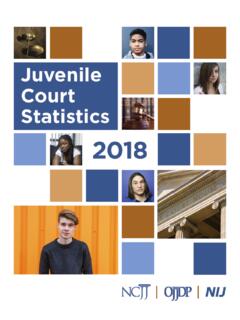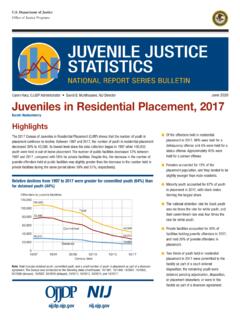Transcription of JUVENILE JUSTICE STATISTICS
1 Department of JUSTICE Office of JUSTICE ProgramsJUVENILE JUSTICE STATISTICSNATIONAL REPORT SERIES BULLETINC aren Harp, OJJDP Administrator David B. Muhlhausen, NIJ DirectorJune 2020 JUVENILE Arrests, 2018 Charles Puzzanchera Highlights This bulletin documents the latest trends in arrests involving juveniles (youth younger than age 18) by drawing on arrest estimates developed by the Bureau of JUSTICE STATISTICS and the National Center for JUVENILE JUSTICE based on analyses of data from the Federal Bureau of Investigation s Uniform Crime Reporting Program. Overall, JUVENILE arrests have been on the decline for more than a decade, but patterns vary by demographic group and offense. In 2018, law enforcement agencies made an estimated 728,280 arrests of youth younger than 18 the fewest arrests of juveniles in nearly four decades Number of arrests, youth ages 0 17 3,000,000 2,500,000 2,000,000 1,500,000 1,000,000 500,000 0 Total arrests 82 86 90 94 98 02 06 10 14 18 Year n Arrests of juveniles (youth ages 0 17) peaked in 1996, at nearly million.
2 Arrests of juveniles havesince declined the number in 2018 was 73% below the 1996 peak. In comparison, arrests of adultsfell 22% during the same period. Data source: Analysis of arrest data from the Bureau of JUSTICE STATISTICS and the National Center for JUVENILE JUSTICE . (See data source note on page 13 for details.) nAfter increasing between 2012 and 2017,the JUVENILE arrest rate for murder heldsteady through 2018, while the rates forrobbery and aggravated assault reached anew low in arrest rates for property crimeshave declined in recent years. By 2018, JUVENILE arrest rates for larceny-theft,burglary, and arson were at their lowestlevels since at least 1980, while rates formotor vehicle theft increased annually violent crime arrest rate for olderjuveniles (ages 15 17) was lower than therates for young adults (ages 18 20 and21 24).
3 NMale and female JUVENILE arrest rates havedeclined in the last 10 years; however, therelative declines have been greater formales than for females across manyoffenses. As a result, the female share ofjuvenile arrests has grown since arrest rates involving violent crimes(such as murder and robbery) tend to bemuch higher for black youth than for whiteyouth. Conversely, arrest rates for liquor lawviolations were higher for American Indianand white youth than black 2 National Report Series Bulletin The FBI s UCR Program provides data about JUVENILE arrests A Message From OJJDP and NIJ This bulletin summarizes recent trends in JUVENILE arrests in the United States based on data from the Federal Bureau of Investigation s Uniform Crime Reporting program.
4 The cumulative data in this bulletin reveal recent and long-term shifts in JUVENILE arrests based on offense, gender, and race. It is a useful tool for JUVENILE JUSTICE practitioners, researchers, policymakers, and others who seek to prevent, intervene in, and respond to JUVENILE delinquency. The number of arrests involving juveniles in 2018 was at its lowest level since at least 1980, and much of the decline has occurred in the past 10 years. Between 2009 and 2018, the number of JUVENILE arrests fell 60%. Among violent crimes, arrests for murder increased 21%, arrests for robbery declined 11%, and arrests for aggravated assault declined 8% between 2014 and 2018. In 2018, there were an estimated 125,030 JUVENILE arrests for simple assault. Nearly 4 in 10 (37%) of these arrests involved females, more than 4 in 10 (41%) involved youth younger than 15, and nearly 6 in 10 (59%) involved white youth.
5 Relative declines in arrests have been greater for boys than for girls across many offenses. As a result, the female share of JUVENILE arrests has grown since 1980. OJJDP and NIJ remain committed to supporting research, programs, and initiatives to combat JUVENILE delinquency and to provide positive outcomes for youth, their families, and their communities. Caren Harp OJJDP Administrator David B. Muhlhausen, NIJ Director What do arrest STATISTICS count? Findings in this bulletin are drawn from data that local law enforcement agencies across the country report to the Federal Bureau of Investigation s (FBI s) Uniform Crime Reporting (UCR) program. To properly interpret the material presented, the reader needs a clear understanding of what arrest STATISTICS count.
6 Arrest STATISTICS report the number of arrests that law enforcement agencies made in a given year not the number of individuals arrested nor the number of crimes committed. The number of arrests is not the same as the number of people arrested because an unknown number of individuals are arrested more than once during the year. Nor do arrest STATISTICS represent the number of crimes that arrested individuals commit because a series of crimes that one person commits may culminate in a single arrest, and a single crime may result in the arrest of more than one person. This latter situation, where many arrests result from one crime, is relatively common in JUVENILE law-violating behavior because juveniles* are more likely than adults to commit crimes in groups.
7 For this reason, one should not use arrest STATISTICS to indicate the relative proportions of crime that juveniles and adults commit. Arrest STATISTICS are most appropriately a measure of entry into the JUSTICE system. Arrest STATISTICS also are limited in measuring the volume of arrests for a particular offense. Under the UCR program, the FBI requires law enforcement agencies to classify only the most serious offense charged in an arrest. For example, the arrest of a youth charged with aggravated assault and possession of a weapon would be reported to the FBI as an arrest for aggravated assault. Therefore, * In this bulletin, JUVENILE refers to persons younger than age 18. In 2018, this definition was at odds with the legal definition of juveniles in nine states seven states where all 17-year-olds are defined as adults, and two states where all 16- and 17-year-olds are defined as adults.
8 When arrest STATISTICS show that law enforcement agencies made an estimated 17,170 arrests of young people for weapons law violations in 2018, it means that a weapons law violation was the most serious charge in these arrests. An unknown number of additional arrests in 2018 included a weapons charge as a lesser offense. Crime in the United States Reports Data on Murder Victims Each Crime in the United States report, published by the FBI, presents estimates of the number of crimes reported to law enforcement agencies. Although many crimes are never reported, murder is one crime that is nearly always reported. An estimated 16,214 murders were reported to law enforcement agencies in 2018, or murders for every 100,000 The murder rate was essentially constant between 1999 and 2006 and then fell 22% through 2014, reaching its lowest level since at least 1980.
9 The rate increased 19% through 2017 then fell 7% in the past year. Of all murder victims in 2018, 92% (or 14,908 victims) were 18 years old or older. The other 1,306 murder victims were younger than age 18 ( , juveniles). The number of JUVENILE murder victims declined 33% between 2007 and 2013, reaching its lowest level since at least 1980. After reaching that historic low, the number of JUVENILE murder victims increased 16% through 2017 and then declined 6% in the past year. As a result, the number of JUVENILE murder victims in 2018 was 9% above the 2013 low point and 55% below the 1993 peak, when an estimated 2,880 juveniles were murdered. Of all juveniles murdered in 2018, 35% were younger than age 5, 70% were male, 45% were white, and more than half (58%) were killed by a firearm.
10 June 2020 3 In 2018, law enforcement agencies in the United States made 728,280 arrests of persons younger than 18 The number of arrests of juveniles in 2018 was 60% fewer than the number of arrests in 2009 2018 estimated number of JUVENILE arrests Percent of total JUVENILE arrests Percent change Most serious offense Female Younger than 15 White 2009 2018 2014 2018 2017 2018 Total 728,280 30% 30% 62% 60% 29% 10%Violent Crime* 46,140 21 29 47 44 9 5 Murder and nonnegligent manslaughter 920 11 10 40 2221 0 Rape* NA NA NA NA NANA NA Robbery 17,290 11 20 34 45 11 11 Aggravated assault 27,940 28 35 56 44 8 1 Property Crime Index 131,500 32 29 55 69 44 22 Burglary 22,250 13 30 55 70 45 28 Larceny-theft 92,630 39 28 56 71 48 22 Motor vehicle theft 14,780 18 25 45 2616 9 Arson 1,850 17 58 68 65 41 18 Nonindex Other (simple) assault 125,030 37 41 59 43 112 Forgery and counterfeiting 1,040 20 20 57 51 12 15 Fraud 4,710 31 24 41 2310 1 Embezzlement 580 40 5 53 427 9 Stolen property (buying, receiving, possessing) 9,320 16 21 37 50 10 11 Vandalism 30,600 19 38 68 66 32 17 Weapons (carrying, possessing, etc.)
















